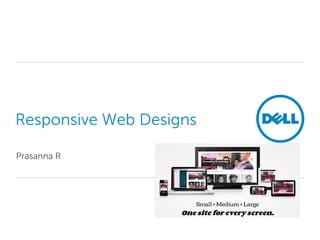Responsive Web Designs
- 2. Responsive Web Design ŌĆō Overview Websites that adapts its layout and design to fit any device that chooses to display it. ŌĆó Multiple devices with access to web browsers ŌĆō Demo Prototying ŌĆō Smartphones; Tablets; Phablets; Netbooks; Monitors; Laptops; TV; Video game consoles ŌĆó Two Options for maintain presence ŌĆō Adaptive (Multiple Fixed Width Layouts ŌĆō Mobile site, Phablet site, tablet site) vs Responsive (Fluid Grid Layouts) ŌĆó RWD - Key Characteristics o Mobile first approach o Web development Follows Progressive Enhancement o Works well for Screen readers (irrespective of JS enabled/disabled) o Users can access the same content across devices ŌĆó What does RWD solve for? ŌĆō Spectrum of Screen Sizes & Resolutions. 2
- 3. Responsive Web Design ŌĆō Key Concepts Fluid Grid + Media Queries = Responsive site ŌĆó Fluid Grid ŌĆō Site is designed based on arbitrary percentage values instead of rigid pixels ŌĆō Layout is squeezed onto a tiny mobile device or stretched ’āĀ All elements resize ŌĆō Ex: Fluid Grid site ŌĆó Media Queries ŌĆó CSS styles are conditionally applied based on the size of the displaying browser using the Min-width feature ŌĆó Entirely redesign the layout for smaller devices ŌĆó Ex: Responsive site 3
- 4. Responsive Web Design ŌĆō Key Concepts Fluid Grid + Media Queries = Responsive site Using Media Queries re-organize the Modules 4
- 5. Challenges It is a fundamental shift. ŌĆó Lack of static design Phase ŌĆō Modular Approach ŌĆō Navigation ŌĆō Tables ŌĆō Images ŌĆō Adaptive Images or Content aware image sizing ŌĆó Converting old fixed sites ŌĆó Old browser versions ŌĆó Testing Time & Cost ŌĆó Exit Photoshop, Enter browser (Ex: Storm Franchise pages) ŌĆó Question Earlier Design Assumptions ŌĆ£Stop Thinking in Pages. Start Thinking in SystemsŌĆØ ŌĆō Jeremy Keith (Web developer and Author, HTML5 for Web Designers) 5
- 6. Approaches to Navigation/Tables Navigation 1. Top Nav or Do Nothing (Demo: Timkadlec, Confab2012) 2. Footer Anchor (Demo: Greygoose, ObamaŌĆÖs Campaign) 3. Select Menu (Demo: Viljamis) 4. Toggle (Demo: Starbucks, Macdonald) 5. Left Nav Flyout (Similar to FB app) 6. Hide and Cry (Demo: Authentic Jobs) Tables 1. Converting each cell into its own line (Demo) 2. Replace it with small mock up table with link to large table (Demo) 3. Hiding less important columns with drop down menu to enable them (Demo) 4. Fix the left most column and others can be scrolled horizontally (Demo) 6
- 7. Approaches to Navigation Top Nav, Footer Anchor, Drop Down, Toggle, Left Nav flyout (FB App & Google) Top Nav Approach Link Footer Approach Link 7
- 8. Approaches to Navigation Top Nav, Footer Anchor, Drop Down, Toggle, Left Nav flyout (FB App & Google) Drop Down Approach Link Toggle Approach Link 8
- 9. Approaches to Navigation Top Nav, Footer Anchor, Drop Down, Toggle, Left Nav flyout (FB App & Google) Filter Link Toggle (Layered Masthead) Link 9
- 10. Approaches to Table Each cell into its own line; replace with small mock table with link to view larger one; display drop down to show other columns, horizontal scroll Convert each cell into its own line Replace it with small Mock up table 10
- 11. Approaches to Table Each cell into its own line; replace with small mock table with link to view larger one; display drop down to show other columns, horizontal scroll Display drop down to show other columns Horizontal Scroll 11
- 12. More elements Responsive Carousel & Forms Responsive Carousel Link Responsive Forms Link 12
- 13. More elements Most of the elements Carousel, Breadcrumb, Forms, Search box, Video, Maps, Notification bars & Tabs can be designed to be responsive. Responsive Tabs + Accordion Fluid Search More Responsive Patterns Codes & modern patterns can be found in Github (Social Coding Platform) Link 13
- 14. Advantages & Disadvantages RWD is the way forward for presence across devices. Responsive Web design is GoogleŌĆÖs recommended configuration Advantages ŌĆó Solving User Experience for the Long Term ŌĆó Analytics: One complete view of all traffic ŌĆó Sharing/Linking: One URL per content ŌĆó SEO: One URL accumulates Page Rank, Page Authority and hence Search engine favour them ŌĆó Low Maintenance ŌĆó High Familiarity/Low learning curve for users: Same information is available in mobile & desktop site. Disadvantages ŌĆó SEO: Difficulty in adjusting Titles, Description & Content by devices as users might use voice search ŌĆō different keywords in mobile ŌĆó Resource intensive development. Green field projects cost much lesser than site upgradation projects 14
- 15. More Examples http://www.anderssonwise.com/ http://us.illyissimo.com/ http://earthhour.fr/ http://forefathersgroup.com/ 15
- 16. More Examples http://staffanstorp.se/ http://foodsense.is/ http://stephencaver.com/ http://2012.dconstruct.org/ 16
- 17. References ŌĆó Beginner Guide: http://blog.teamtreehouse.com/beginners-guide-to-responsive-web-design ŌĆó http://webdesign.tutsplus.com/articles/design-theory/designing-for-a-responsive-web/ ŌĆó Learn more - http://bradfrost.github.com/this-is-responsive/ ŌĆó Framework http://speckyboy.com/2011/11/17/15-responsive-css-frameworks-worth-considering/ ŌĆó Tutorial - http://teamtreehouse.com/library/websites/build-a-responsive-website/introduction-to- responsive-web-design ŌĆó http://zomigi.com/blog/essential-resources-for-creating-liquid-and-elastic-layouts/ ŌĆó Media Queries - http://www.w3.org/TR/css3-mediaqueries/ ŌĆó Fluid Images - http://unstoppablerobotninja.com/entry/fluid-images/ ŌĆó Context aware image sizing - http://filamentgroup.com/lab/responsive_images_experimenting_with_context_aware_image_sizing/ ŌĆó http://mobile.smashingmagazine.com/2011/07/22/responsive-web-design-techniques-tools-and- design-strategies/ ŌĆó http://resizemybrowser.com/ ŌĆó Content Choreagraphy - http://trentwalton.com/2011/07/14/content-choreography/ ŌĆó Guidelines for RWD - http://coding.smashingmagazine.com/2011/01/12/guidelines-for-responsive- web-design/ ŌĆó Responsive Design Examples: http://designmodo.com/responsive-design-examples/ ŌĆó http://bradfrostweb.com/blog/web/responsive-nav-patterns/ 17

















